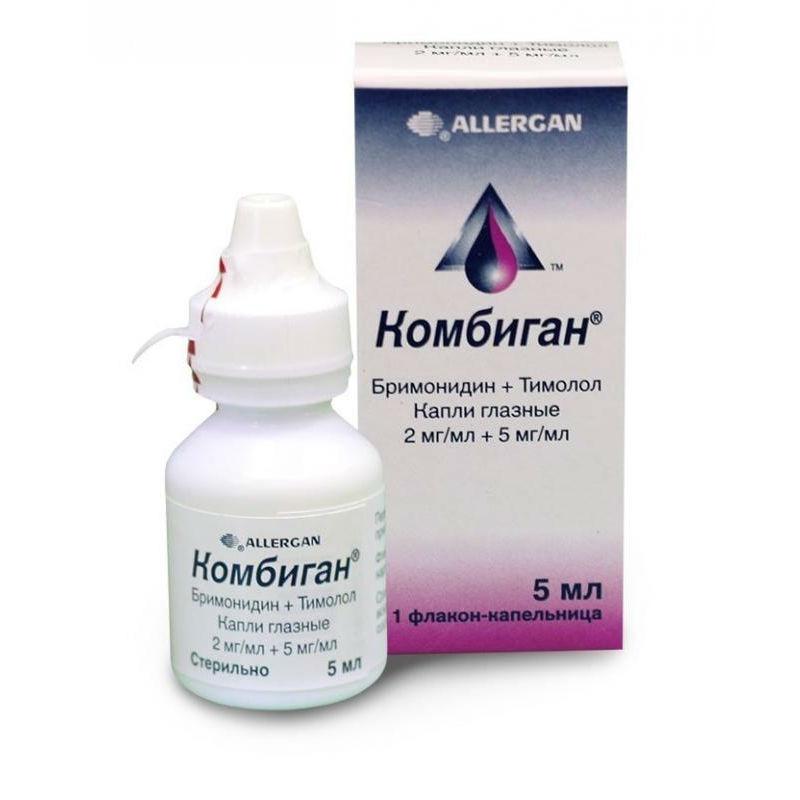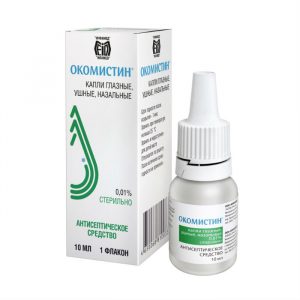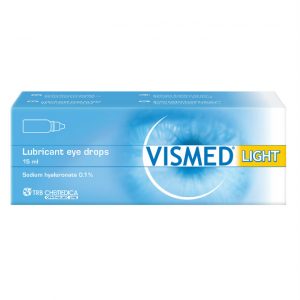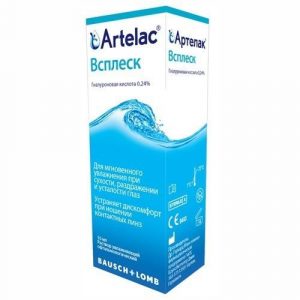Description
Packaging
5 ml – plastic dropper bottle (1) – packs of cardboard.
Pharmacological action
Combigan is a combined drug that contains 2 active substances: brimonidine, an adrenergic agonist that has a stimulating effect on alpha2-adrenergic receptors, and timolol, a beta-adrenergic receptor blocker. Both active substances reduce intraocular pressure (IOP) due to the combined interaction, leading to a significantly more pronounced hypotensive effect compared to the effect of each of the components separately.
Brimonidine – an alpha-adrenergic receptor agonist, moreover, it has 1000 times greater selectivity for alpha2-adrenergic receptors compared to alpha1-adrenergic receptors. Selectivity is expressed in the absence of mydriasis and vasoconstriction of the vessels of the microvasculature. The hypotensive effect of brimonidine is ensured by reducing the formation of intraocular fluid and increasing its outflow along the uveoscleral pathway.
Timolol is a non-selective beta-blocker, does not have internal sympathomimetic and membrane-stabilizing activity. Timolol reduces IOP by reducing the formation of intraocular fluid. The exact mechanism of action has not been established, it may be associated with inhibition of the synthesis of cyclic adenosine monophosphate (cAMP) and is caused by endogenous stimulation of beta-adrenergic receptors.
Pharmacokinetics
Average values of the maximum concentration of the drug in blood plasma (Cmax) of brimonidine and timolol after application of the preparation Combigan ® were 0.0327 and 0.406 ng / ml, respectively.
Brimonidine
When installing a 0.2% solution in the form of eye drops, the concentration of brimonidine in the blood plasma is very low. Brimonidine is slightly metabolized in the tissues of the eye, communication with plasma proteins is about 29%. The half-life (T1 / 2) of the drug after topical application is on average about 3 hours.
The main part of the drug (about 74% of the dose absorbed into the systemic circulation) is excreted by the kidneys in the form of metabolites within 5 days, an unchanged drug in the urine was not found. In vitro studies on animal and human liver cells have shown that aldehyde oxidase and cytochrome P450 are largely included in the metabolism process. Therefore, systemic excretion is determined primarily by the metabolism of the drug in the liver.
Timolol
80% of timolol, used in the form of eye drops, enters the systemic circulation by absorption through the vessels of the conjunctiva, nasal mucosa and lacrimal tract. After the installation of eye drops, the maximum concentration of timolol in the aqueous humor of the eye is reached after 1-2 hours. The half-life (T1 / 2) of timolol in blood plasma is about 7 hours. Timolol slightly binds to plasma proteins. Timolol is partially metabolized in the liver, the active substance and its metabolites are excreted by the kidneys.
Indications
open-angle glaucoma
ophthalmic hypertension (with insufficient effectiveness of local therapy with beta-blockers).
Contraindications
Hypersensitivity to the components of the drug.
Increased airway reactivity, including: Bronchial asthma.
Bronchial obstruction, incl. history of severe chronic obstructive pulmonary disease.
Sinus bradycardia.
Atrioventricular block II-III degree without implanted artificial pacemaker.
Heart failure.
Cardiogenic shock.
Concomitant therapy with monoamine oxidase inhibitors (MAOs), antidepressants – tricyclic and tetracyclic (including mianserin).
Age to 18 years.
Breastfeeding period.
Caution:
Renal / liver failure (use of the drug is not well understood in this group of patients).
Depression
Cerebral or coronary insufficiency.
Reynaud’s Syndrome.
Orthostatic hypotension
Obliterating thromboangiitis.
Severe cardiovascular disease of an unstable course.
Diabetes mellitus.
Episodes of hypoglycemia (in the absence of therapy).
Pheochromocytoma (without prior treatment).
metabolic acidosis.
Concurrent use of radiopaque drugs.
Intravenous administration of lidocaine, slow calcium channel blockers (verapamil, diltiazem) due to the risk of inhibition of atrioventricular conduction, the development of bradycardia, heart failure and lowering blood pressure.
The simultaneous administration or change in the dose of drugs from the groups of adrenergic agonists (isoprenaline) and adrenergic blockers (prazosin), as well as other drugs that affect adrenergic transmission – due to their possible interaction with the active components of the drug or changes in their therapeutic potential.
Use during pregnancy and lactation
There have been no controlled studies on the use of Combigan in pregnant women.
Brimonidine
There is no data on the use of brimonidine in pregnant women. Animal studies have demonstrated reproductive toxicity at high doses with toxic effects for the mother. The degree of risk to humans has not been established.
Timolol
In animal studies, reproductive toxicity has been established when using doses of the drug that are significantly higher than those recommended for use in clinical practice. In epidemiological studies, no congenital malformations of the fetus were detected, but the risk of intrauterine growth retardation during oral administration of beta-blocker drugs is known. In addition, symptoms characteristic of the group of beta-blockers (bradycardia, decreased blood pressure, respiratory dyspnea and hypoglycemia) were observed in newborns in cases where beta-blockers were used by the mother until delivery.
In this regard, if Combigan is prescribed during pregnancy until the time of birth, medical monitoring of the condition of the newborn during the first days of life is necessary.
Combigan can be used during pregnancy only if absolutely necessary.
During lactation
Preclinical studies have found that brimonidine and timolol are excreted in breast milk. Breastfeeding for the treatment period should be discontinued.
Composition
In 1 ml of a solution of eye drops contains:
Active ingredients: Brimonidine tartrate – 2.0 mg / ml.
Timolol maleate – 6.8 mg / ml. In terms of timolol – 5.0 mg / ml.
Excipients: benzalkonium chloride, sodium hydrogen phosphate heptahydrate, sodium dihydrogen phosphate monohydrate, hydrochloric acid, sodium hydroxide, water.
Dosage and administration of
In adults, including elderly patients:
Locally, instill in the conjunctival sac of the affected eye 1 drop 2 times / day with an interval of 12 hours.
Combigan can be used with other ophthalmic drugs to reduce intraocular pressure. If you use more than 2 drugs, then you need to take a 5 minute break between instillations.
As with other eye drops, to reduce possible systemic absorption, a short-term (within 1 minute) pressure on the lacrimal sac in the area of the projection of the lacrimal sac of the eye at the inner corner of the eye is recommended.
Side effects of
The most common side effects were conjunctival hyperemia of the eye (about 15% of patients) and burning sensation of the mucous membrane of the eye (approximately 11% of patients). In most cases, the severity of these symptoms was weak, discontinuation of therapy was required only in 3.4% and 0.5% of cases, respectively.
In clinical trials of Combigan ®, the following side effects were reported, taking into account the frequency of occurrence: very often (> 1/10) often (> 1 / 100.1 / 1000,
On the part of the organ of vision:
very often: hyperemia of the conjunctiva of the eye, burning sensation.
often: acute burning or stitching pain, allergic conjunctivitis, corneal erosion, superficial keratitis, itchy eyelid skin, conjunctival folliculosis, impaired vision, blepharitis, epiphora, dry mucous membranes of the eye, discharge from the eye, pain, irritation of the mucous membrane of the eye, foreign sensation body.
infrequently: decreased visual acuity, conjunctival edema, follicular conjunctivitis, allergic blepharitis, conjunctivitis, floating precipitates in the vitreous body, asthenopia, photophobia, hypertrophy of the papillary muscles of the eye, soreness of the eyeglasses, conjunctival conjunctiva, papillum conjunctiva Mental disorders: often depression.
From the nervous system:
often – drowsiness,
headache infrequently – dizziness, syncope.
From the cardiovascular system:
often – high blood pressure
infrequently: congestive heart failure, palpitations.
From the respiratory system:
infrequently: rhinitis, dry nasal mucosa.
From the digestive system:
often – dry oral mucosa
infrequently – a perversion of taste.
From the skin and subcutaneous fat:
often – swelling of the eyelids, itching of the eyelids, redness of the skin of the eyelids
infrequently – allergic contact dermatitis.
Other disorders:
is often an asthenic condition.
Laboratory indicators: often – increased activity of liver enzymes.
The following side effects have been reported additionally since the launch of Combigan on the market:
From the cardiovascular system:
Frequency unknown – arrhythmia, bradycardia, tachycardia, decreased blood pressure.
Side effects that were observed when using one of the active substances, the possibility of which is not excluded with the use of the drug Combigan:
Brimonidine
From the organ of vision: iridocyclitis, myosis.
Mental Disorders: Insomnia.
On the part of the respiratory system: inflammatory diseases of the upper respiratory tract, shortness of breath.
From the digestive system: taste perversion, dyspepsia. Other: systemic allergic reactions.
timolol
From the side of the organ of vision: decreased sensitivity of the cornea, diplopia, ptosis, rupture of the choroid (after filtration surgical treatment), changes in refraction (due to the cancellation of myotic therapy in some cases).
Mental disorders: insomnia, nightmares, decreased libido.
From the nervous system: memory loss, worsening symptoms of myasthenia gravis, paresthesia, cerebral ischemia. On the part of the hearing organ: tinnitus.
From the cardiovascular system: complete transverse blockade of the heart, cardiac arrest.
Vascular disorders: cerebrovascular accident, intermittent claudication, Raynaud’s syndrome, cold extremities. From the respiratory system: bronchospasm (mainly in patients with a history of bronchial obstructive diseases), shortness of breath, cough, respiratory failure.
From the digestive system: nausea, diarrhea, dyspepsia.
From the skin and subcutaneous fat: alopecia, psoriasis-like rash or exacerbation of psoriasis.
From the musculoskeletal system, connective and bone tissue: systemic lupus erythematosus
Other: peripheral edema, Peyronie’s disease, chest pain.
Drug Interaction
No specific studies on the drug drug interaction of Kombigan ® have been performed. However, the possibility of enhancing the effect of drugs depressing the central nervous system (alcohol, barbiturates, opium derivatives, sedatives, general anesthetics) when used with Kombigan should be considered.
Timolol may aggravate compensatory tachycardia and increase the risk of marked blood pressure drop when used with general anesthetics. It is necessary to warn the anesthesiologist about the use of the drug Kombigan before the upcoming surgery.
The development of mydriasis is possible with the timolol and epinephrine administration.
Beta-blockers can enhance the hypoglycemic effect of hypoglycemic drugs. They can also mask hypoglycemia.
The hypertensive reaction to the sudden withdrawal of clonidine may intensify amid the use of a beta-blocker.
An increase in the antihypertensive effect (eg, a decrease in heart rate) when used with timolol together with quinidine may be due to the fact that quinidine slows the metabolism of timolol via the cytochrome P450 isoenzyme, CYP2D6.
Co-administration of beta-blockers with drugs for general anesthesia may mask compensatory tachycardia and increase the risk of marked blood pressure drop, therefore, the anesthesiologist should be warned about the use of Kombigan by the patient.
Cimetidine, hydralazine, ethanol can increase the concentration of timolol in blood plasma.
Medicines that have an effect on the metabolism and absorption of circulating catecholamines, such as chlopromazine, methylphenidate, reserpine, should be used with caution. Concomitant administration of MAO inhibitors is contraindicated. For patients receiving MAO inhibitors, treatment with Kombigan may be given 14 days after withdrawal of the MAO inhibitor.
Reported potentiation of the effects of co-administration of eye drops containing timolol and the intake of slow calcium channel blockers, guanethidine or beta-blockers, antiarrhythmic drugs, cardiac glycosides or parasympathomimetics, which was manifested by marked decrease in blood pressure and / or pronounced bradycardia. After the use of brimonidine in very rare cases (
Overdose
Brimonidine
Overdose with topical use: loss of consciousness, decreased blood pressure, bradycardia, hypothermia, cyanosis and apnea.
Overdose with accidental oral ingestion: with accidental ingestion of brimonidine clinical manifestations included: CNS depression, short-term confusion, loss of consciousness or coma, reduction of blood pressure, bradycardia, hypothermia and apnea, which resulted in indigestion, in some cases, the tracheal intubation was performed. Full restoration of functions was reported in all declared cases between 6 and 24 hours. At an overdose caused by drugs of group of alpha2-adrenomimetics, the following symptoms were reported: reduction of blood pressure, asthenia, vomiting, drowsiness, sedation, bradycardia, arrhythmias, miosis, apnea, hypothermia, respiratory depression, convulsions.
timolol
Symptoms of a general overdose of timolol: bradycardia, blood pressure lowering, bronchospasm, headache, dizziness, cardiac arrest. In a clinical study, it was shown that timolol was not completely excreted in hemodialysis.
If an overdose is diagnosed, symptomatic therapy
Storage conditions
In a dark place at a temperature of no higher than 25 ° C. Keep out of the reach of children.
Expiration
1 year and 9 months.
Active ingredient
Timolol
dosage form
dosage form
eye drops
Allergan, United States




